
Thursday November 19, 2009
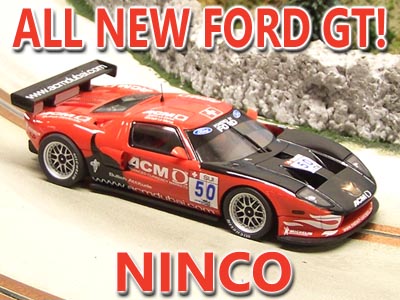
FORD GT - GT3 'MATECH DUBAI'
Item # 50549
Scale: 1/32
This might be one of the most interesting models we have seen from NINCO in a long time. I guess that is a matter of opinion of course, but the Ford GT is a popular model with many enthusiasts and when they first posted photos and announced this new release, I looked forward to it.
So the big question is? Did they do it right? Well, as usual we will let the photos try to let you make up your own mind. Comparing to prototype photos I think NINCO pretty much nails it.

Like anything else, it is your personal decision. I will say the overall fit and finish is about as good as it gets. The only oddity is the mirrors. Although they seem to be the correct shape are missing logos on them compared to the prototype and thus did not get any clear-coat. This really makes them stand out as appearing unfinished, which they are. A small thing, but with the rest of this model having such a great effort put into it, this omission baffles me.
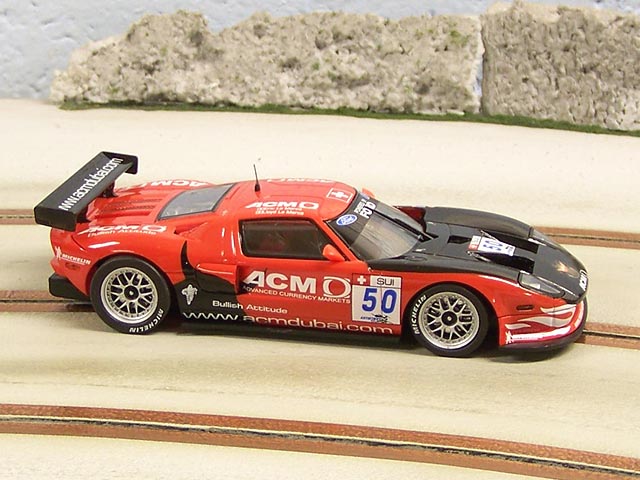
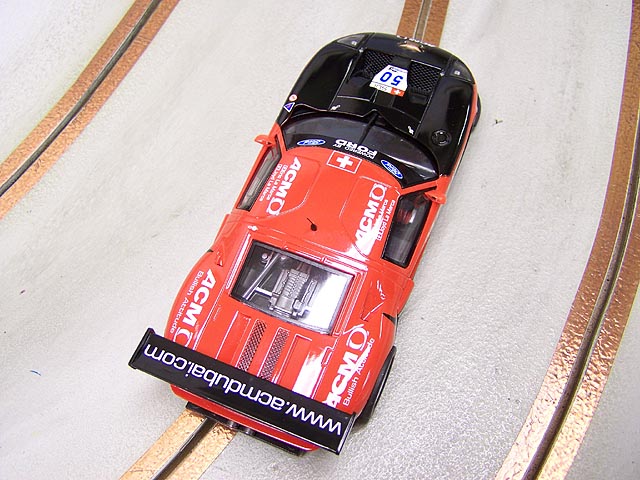
The rest of the detail level is really well done. Using screen mesh for the ducts and front air dam is an eye catcher. So is what little you can see in the interior. NINCO has made improvements over the years and this model shows them off well.
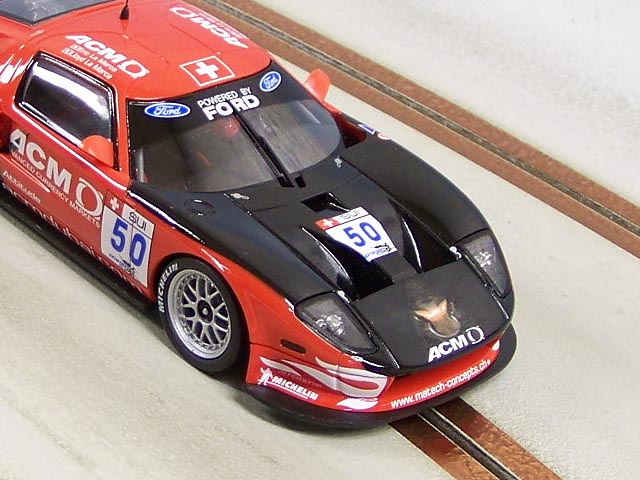
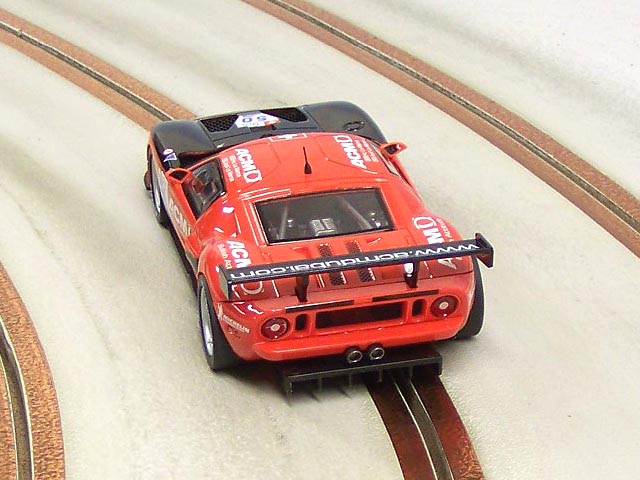
The rear wing may not stand up to harder racing forever, but so far it has taken a few good pops and remains intact. The antenna on top will also not last very long if you can't keep your car planted. Still, it is the small details enthusiasts have asked for in 1/32nd scale and NINCO answered.
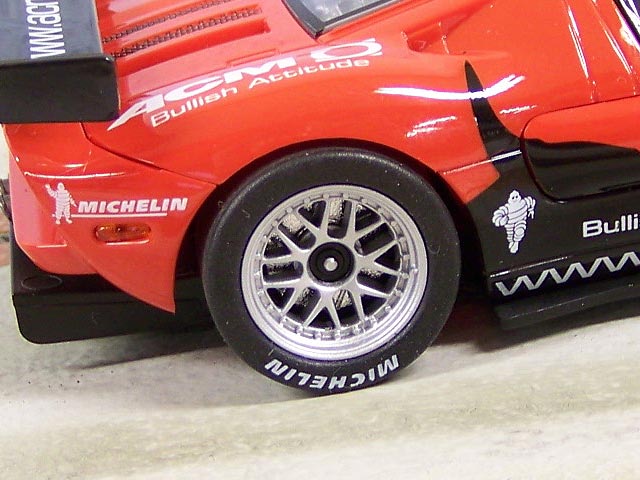
The wheels and tires here are really well done. Design is very close to scale with visible brake rotor detail that truly sets the model off. The big plus is the white lettering on the tires. This has not always been a standard for NINCO. Good call, because without the lettering the work on the rest of the car might have been unappreciated. The lettering seals the scale effect for me.
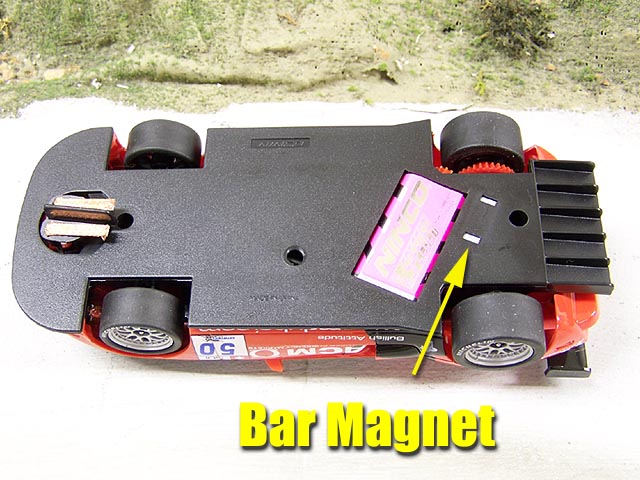
Looking underneath we see this is equipped with the popular NC-5 Speeder motor (20,000 RPMs @ 14.8 volts.) in the angle-winder configuration with the new bar magnet directly behind it. I was surprised to find this motor here, but in reality I suppose I should not be. I expected this second car adorned with the "SPORT" logos on the box to feature the newer "Sparker" motor. But one thing about NINCO is that there seems to be no way of knowing what motor you are going to get. Both motors are 20,000 RPMS so racing should be close, but the torque is slightly different. I suspect it was chosen as it fit the model where as in the Lotus the shorter can was needed.
"SKID PAD TESTING"
Standard Plastic Track @ 12 volts
Parma 35 OHM Control
BOX STOCK
Since we do not have a permanent plastic track set up, I made a quick little track using a few straights and curves. Nothing elaborate, but at least something to test the model on. This car is very quick and the tires hook up rather well. Acceleration and braking are very good too. The magnet has decent attraction so most magnet racers who like stock or a light magnet action should be happy. It does however make this car want to lift out up front. This can be looked at later on I am sure, but it could stand a little weight up front. As it is though, it functions as intended on a plastic track surface as it should.
Box Stock Track
Testing
MidMo International
Speedway
4 x 16 - 3 Lane MDF Routed Wood - Flat Latex Surface
Copper Tape Conductivity - Aftermarket Power @ 12 Volts PARMA 25 OHM Control
On our routed track the car was "ok". Right away it was clear the wheels and tires needed some work. The tires were not fully seated on the wheels which usually indicates some wheel flashing is present. It was also clear we needed some weight up front. The reader should know that these are not issues that I can really discredit NINCO for.
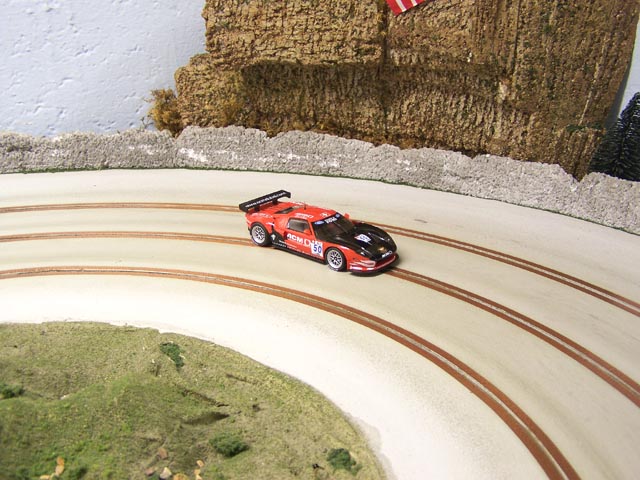
Almost all of our ready to run 1/32nd scale models need a little work here and there to function the way we want them to on a routed track surface. The only thing missing is lights. I think it is time NINCO catch up with our other major brands and put lights in if the car is supposed to have them. This is just my personal preference of course. You might like it just as it is.
Under The Hood
Only 2 screws mount the body to the chassis and are easily removed. Here we have our top down perspective of the chassis.
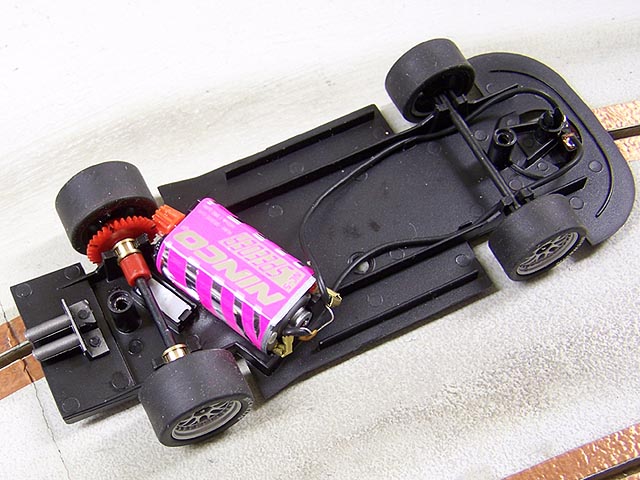
When you look at the body, you will notice that although the interior is deeper for more detail, we still have room to work with in the chassis.
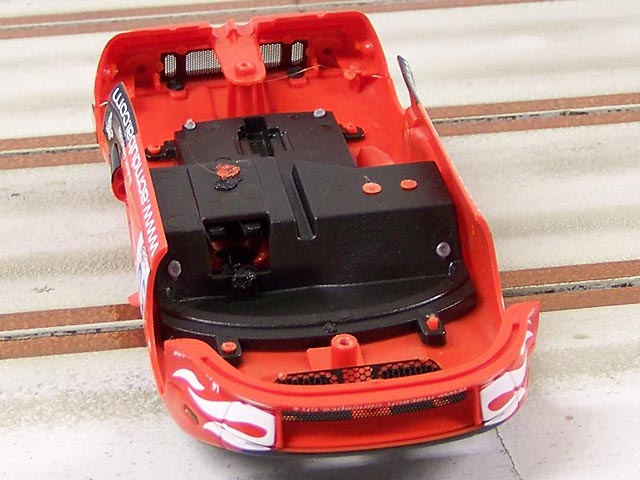
This is good as some may want more magnet perhaps mid-chassis. This would help pin the car down up front a little. It also leaves room for "lead heads" like myself who race non-magnet.
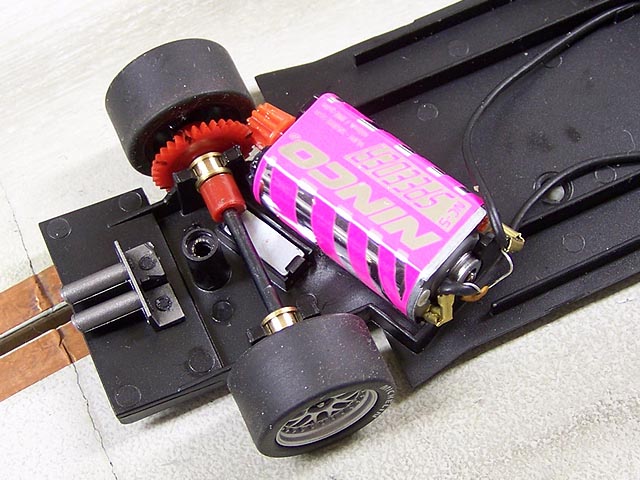
The Speeder motor has a 12 tooth pinion that matches up with the low profile 32 teeth spur gear. The gear mesh here is good but over time break-in will make things even better. One of the first things some might want to do is secure this motor a little better.

I did notice it rocking slightly under full throttle. Using a little hot glue across the motor cured that issue. I like hot glue a great deal. It is strong on most applications, but is easily enough removed with a quick slice of your Exacto knife.
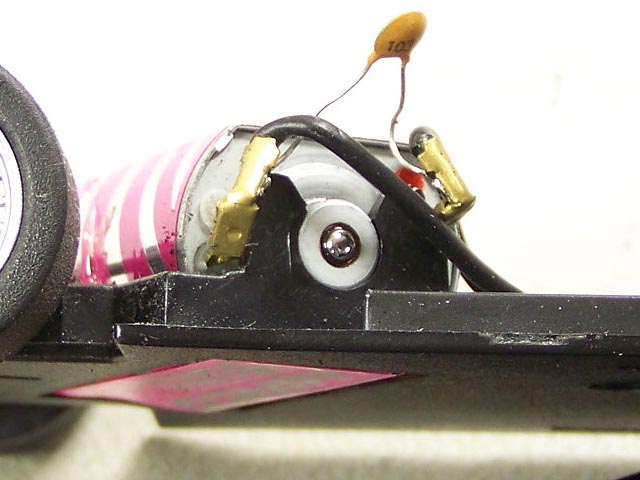
HOLD IT! STOP THE PRESSES! What is this? This is not the same SPEEDER motor of days past. Although the wrapper is the same color, the printing has changed. But that is not the big deal here. The end bell is now exposed allowing you to lubricate both ends of the motor. Well know, that is a change I like. And to save you some time, yes I checked 4 different SPEEDER motors and all of them were sealed.
Next I inspected the front axle. It appears there is a little too much Vertical free-play for my taste. No matter, we have dealt with this issue for years with NINCO. The free-play is here as this works well for uneven plastic tracks, but for wood I want to reduce the front body roll. I wanted to use material that I had a part number for to pass along. In truth, just use anything that will block up the axle, yet still allow it to spin freely.
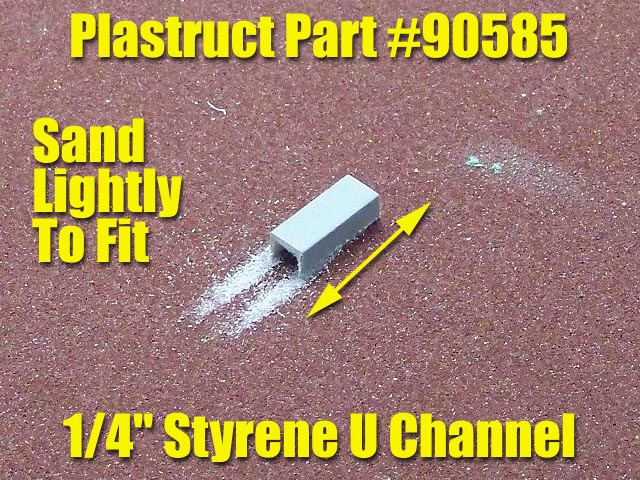
I used some Plastruct part# 90585 U channel material. This worked, but was slightly too high. Solution? Sand it! Just a few passes over some coarse sandpaper had it setting perfect. I then secured them in place with Testors model glue.
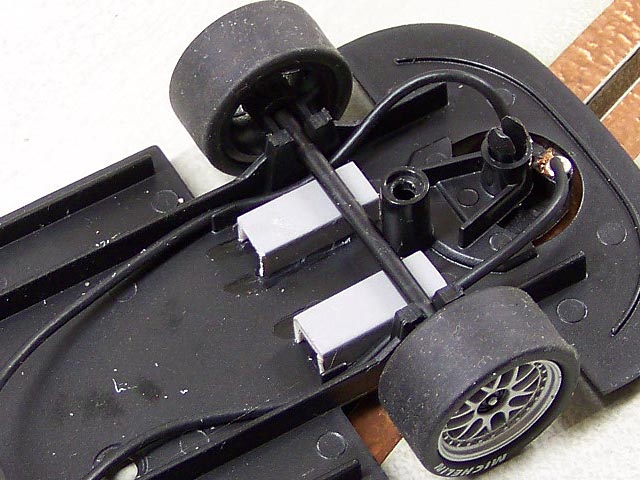
Finally the wheels and tires. After removing the tires we the areas where the excess flash molding is. There was more of it than usual, but no matter as it is easily fixed in just a few seconds. For the rears I just set the model on some sandpaper and gave a few quick bursts of the throttle. Done. The wheels are now very smooth and as true as possible. I re-installed the tires and performed some sanding using the same sandpaper. The fit of the tires was much improved and the tires only needed a few bursts to make them as true as possible.
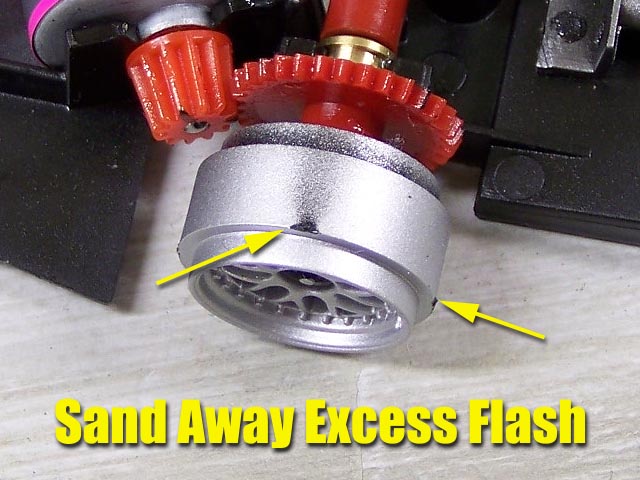
For the fronts I used and Emory board and just lightly sanded them until they were clean. This is easy enough to by hand just take your time and sand both the top and sides of the wheel rib until you feel it is smooth.
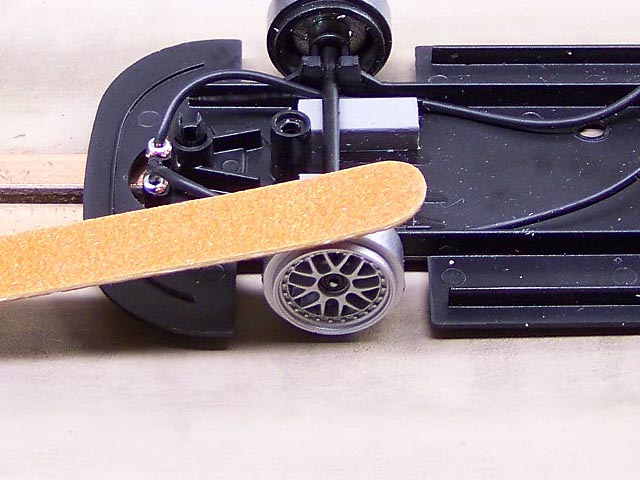
Second Track Test
The first few laps told the story. We now have a much smoother race car that we can begin to tune using various placements and amounts of lead. Once the wheel hop was cured this little slot car is as much fun as you could ask for. I put a little lead up front to see if I could help pin the front down a little more.

We also loosened the body mount screws a little to give it some slight float. ZOOM. This was a good setup and the model really chews up the corners. Yes, this is a nice model indeed. We had lap averages in the 4.0 second range which made it a close match with the latest Lotus. The Lotus seems to have a slight edge on our home track, but on your track the Ford might be King.
Final Thoughts
Lately I have focused on what our models cost more than I have in past. I feel it is important as it allows the enthusiast to see what sort of bang they are getting for the buck. With that said, I want to change things up a little. Normally I only post the MSRP, but after speaking with many fellow racers out there, this really is not fair. The MSRP on this model is close to $70.00 ($69.98) which makes it a little high for many regular home racers. But check your local dealer! Just because that is the MSRP does not mean that is what you can find it for. Shop around! I checked a couple better dealers and see this model around $52-53.00. This makes the car a little more affordable and that price range is one I can live with.
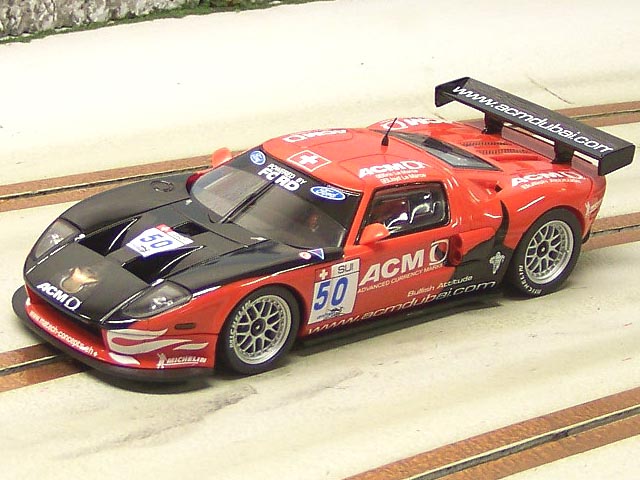
Although still a few dollars more than other models, at least this car has more going for it. It is an all new model and it simply looks fantastic. This is perhaps my pick for the NINCO product of the year. Then again I am biased as I love The Ford GT. I like this car and when the running mate to this model comes along, I want it. It has great potential to be a contender in some of the various classes you might be running in your club plus it makes just a fun car to race in your simple home racing. NINCO did a good job on this car and you might want to look very closely at adding it to your collection.
- Harry
As always feel free to contact me about this article or just the hobby in general at harry@homeracingworld.com, or better yet drop into our Message Forum and share your thoughts with other enthusiasts!
Thanks Go To MRC For Providing Us With This Sample!
Copyright © 2008 HomeRacingWorld.com All Rights Reserved